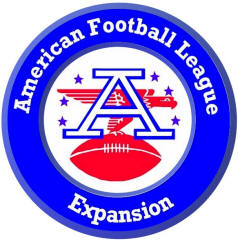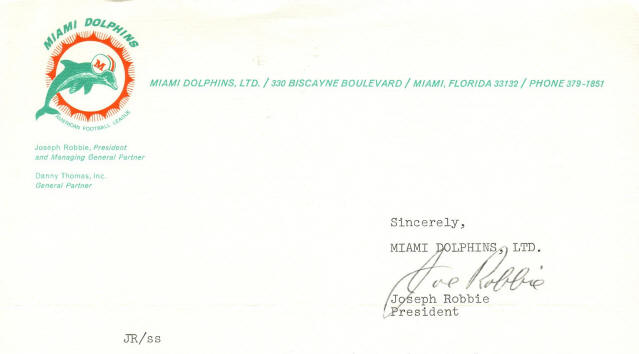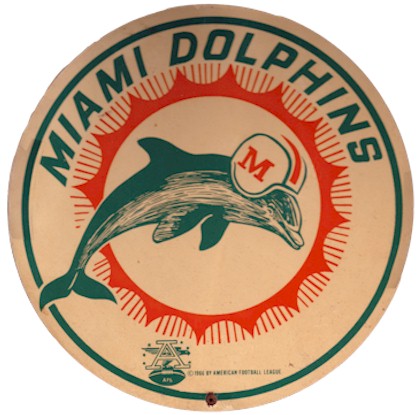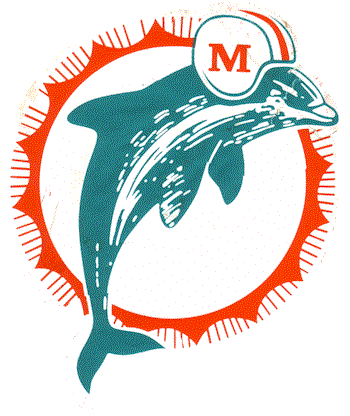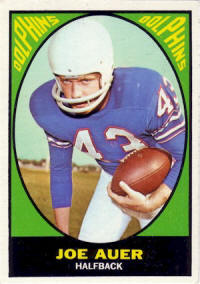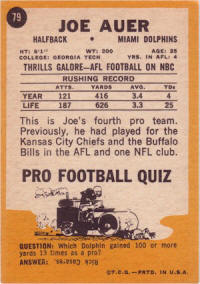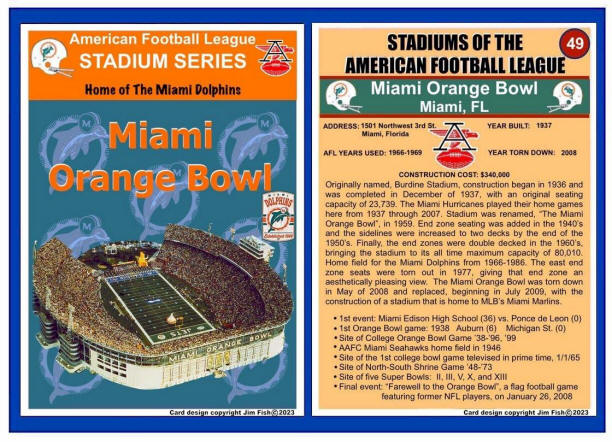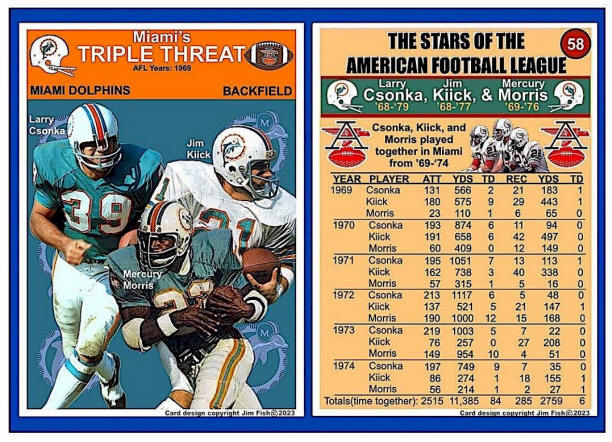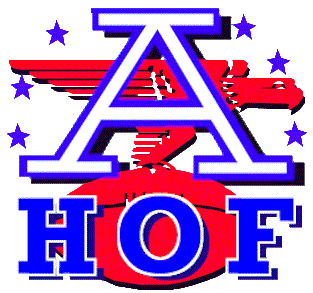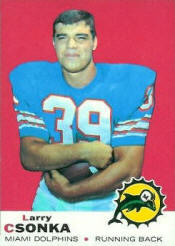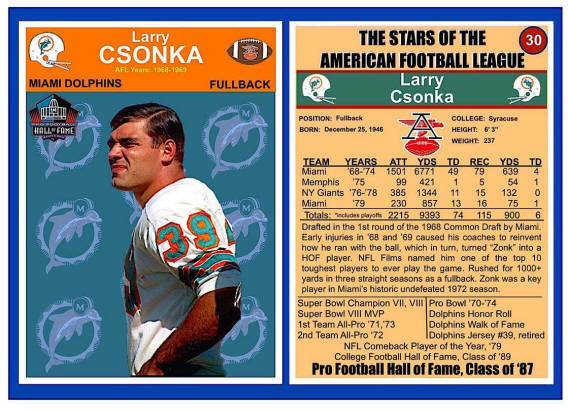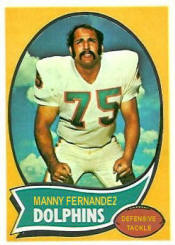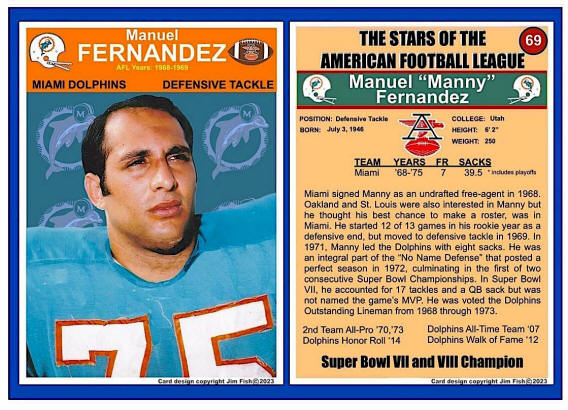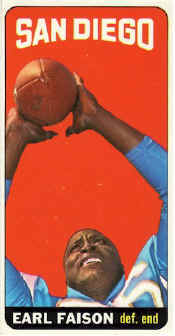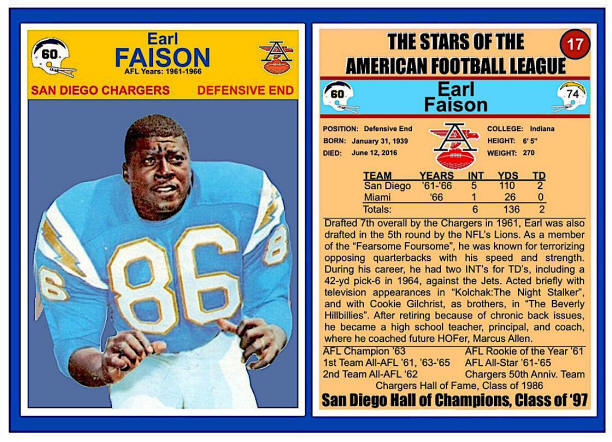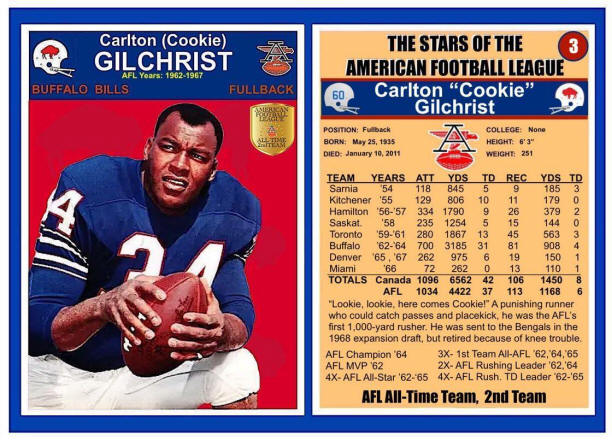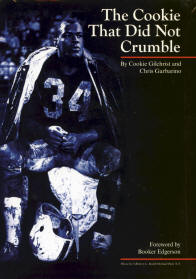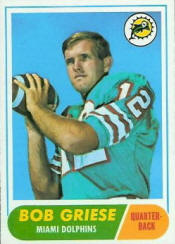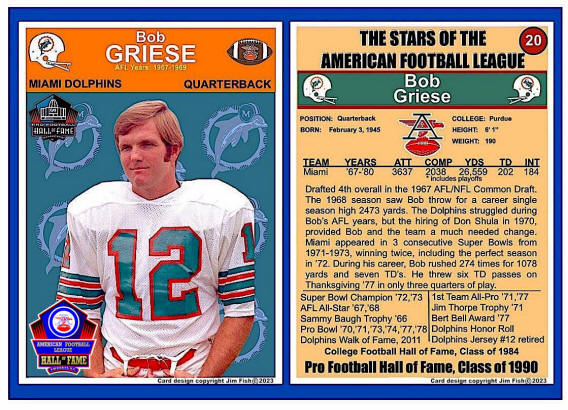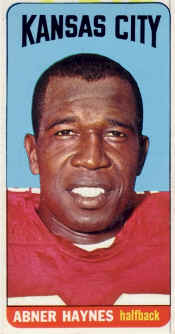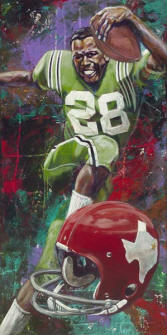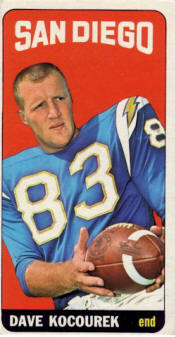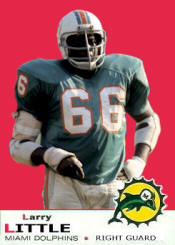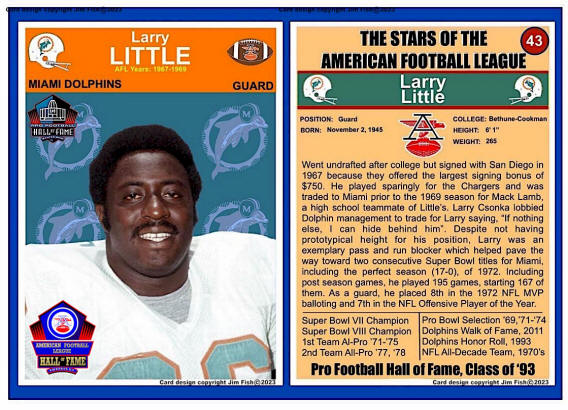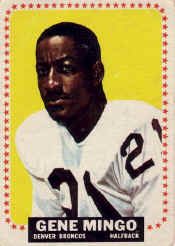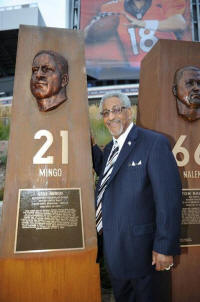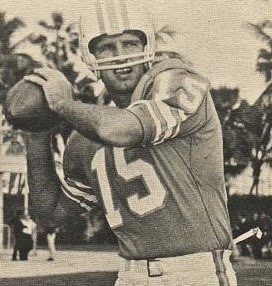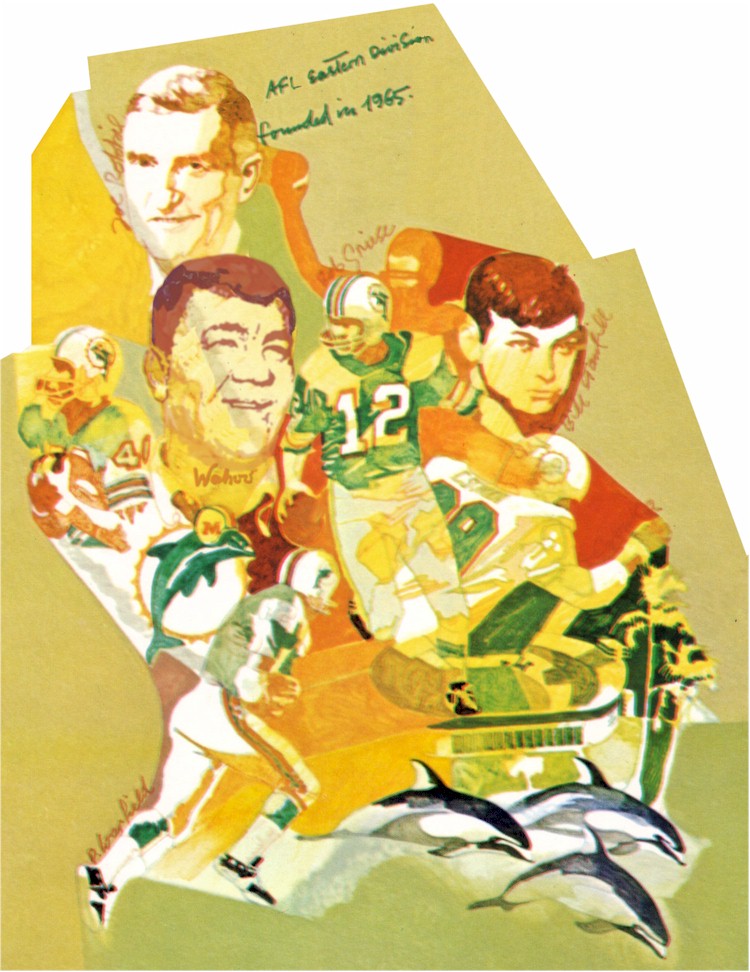The Miami Dolphins were finishing up their inaugural AFL season as
they hosted the Houston Oilers on December 18, 1966. As was typical
of expansion teams, the Dolphins struggled and had lost six straight
games to be 2-11 heading into the last week. Head Coach George
Wilson, who once guided the Lions to a NFL title, had some talent to
work with, especially in the defensive backfield. TE Dave Kocurek,
formerly of the Chargers, was an able veteran and HB Joe Auer showed
all-purpose skill, but fullback was a chronic problem and Cookie
Gilchrist, who arrived at midseason, was an established talent but
also, at age 31, showing wear. Quarterback was the biggest problem
of all, and injuries had severely depleted the position.
Ex-Jet
Dick Wood started the year, but completed only 36 percent of his
passes and yielded to first draft choice Rick Norton, who went down
with a broken jaw, and the coach’s son, George Wilson Jr., who led
the team to two wins before being sidelined.
QB John Stofa (pictured above) had been unheralded coming out of
the University Buffalo 1964, but performed well with minor
league teams. He had tried out with the Dolphins, but was let go
after two weeks in training camp, failed in a further trial with
the Steelers in the NFL, and started the season with the
Lakeland Brahmans of the North American Football League while
teaching school on the side. He had good size at 6’3” and 210
and performed impressively for the Brahmans, throwing for 2029
yards and 23 touchdowns (including 451 yards and 7 TDs in one
game against the hapless Chattanooga Redskins) before being
re-signed by Miami. Now, with Wood unable to play due to a rib
injury, Stofa was getting a chance to start in the finale.
The Oilers, coached for the second time around by Wally Lemm,
were having their problems and had lost to the Dolphins in their
previous meeting, the first of seven straight defeats that had
them arriving in Miami with a 3-10 tally. Houston started off
the year with a veteran-laden roster, and now younger players
were getting an opportunity. Most notably, third-year QB Don
Trull was finally starting ahead of 39-year-old George Blanda,
and rookie FB Hoyle Granger was seeing more action in place of
Charley Tolar and John Henry Johnson, aged 29 and 37,
respectively.
There were 20,045 fans in attendance at the Orange Bowl with
weather in the 70s. The Oilers had the first possession and
punted. After Cookie Gilchrist ran twice for a net of zero
yardage, John Stofa completed his first three passes before
giving up an interception to FS Jim Norton.
Houston again had to punt and the Dolphins reached Oilers’
territory thanks to a 20-yard run by Joe Auer and a Stofa pass
to Dave Kocurek for 11 yards. But after getting to the Houston
36, Stofa was sacked by DE Gary Cutsinger for a loss of 11 yards
and the Dolphins punted.
HB Ode Burrell (pictured at right) returned the kick 29 yards
to the Houston 41 and it took just three plays to travel the
remaining 59 yards. Don Trull threw to Hoyle Granger, who picked
up 25 yards, Burrell ran for seven, and then Trull connected
once more with Granger, who went 27 yards for a touchdown.
George Blanda added the extra point and the visitors took a 7-0
lead into the second quarter.
The Dolphins went three-and-out on their next possession, with
Stofa chased out of bounds for a 19-yard loss on one play, and a
fake punt by George Wilson Jr. picked up 16 yards and gave up
the ball to Houston at the Miami 34. Trull completed a third
down pass to TE Bob Poole for 10 yards, FB John Henry Johnson
ran for another 10, and Trull then threw to flanker Larry Elkins
for an 11-yard TD. Blanda’s point after put the Oilers further
ahead by 14-0.
Down by two touchdowns, the Dolphins responded with an 80-yard
drive in nine plays. Following four running plays, Stofa
connected on passes to Gilchrist for 18 yards, split end Karl
Noonan for 12, and FB Billy Joe for 12 yards to the Houston 27.
After a carry by Gilchrist gained nothing, Stofa went to the air
again and it was complete to Auer for a 27-yard touchdown. Miami
faked a kick for the conversion and Wilson, the holder as well
as backup quarterback and punter, threw to Joe for two points,
making it a 14-8 tally.
A short possession by the Oilers was followed by a punt, giving
the Dolphins the ball at midfield. Auer ran for seven yards, but
Stofa missed on two passes and Gene Mingo’s 50-yard field goal
attempt was short. Houston regained possession with 2:10 left in
the first half and advanced 90 yards. Trull completed passes to
Burrell for 34 and 30 yards and to TE Bob McLeod for a two-yard
TD with nine seconds remaining on the clock. Blanda’s PAT made
the halftime score 21-8.
The Dolphins had the ball first in the third quarter and Stofa
completed three passes, one to Auer for 17 yards who also had a
21-yard gain on a running play around end. A facemask penalty on
the Oilers and a four-yard run by Auer got the ball to the
Houston nine, but Stofa’s pass intended for Gilchrist was picked
off by LB Ronnie Caveness. The Oilers were only able to reach
their 31 before punting, and the Dolphins punted it back after a
short possession.
With Burrell and Granger carrying the load on the ground,
Houston made it just past midfield before having to try for a
long field goal. Blanda’s attempt from 53 yards failed and the
Dolphins scored again in three plays. Stofa threw to flanker
Frank Jackson for 20 yards, Gilchrist rushed for six, and
another throw to Jackson was good for a 48-yard touchdown. Mingo
kicked the point after and Houston’s lead was cut to 21-15.
Miami got the ball back quickly when, on the second play
following the ensuing kickoff, CB Jimmy Warren intercepted a
Trull pass. As the game moved into the fourth quarter, the
Dolphins were unable to get any farther than the Houston 47 and
punted.
The Oilers drove 80 yards in 12 plays. Trull (pictured at left)
had completions to McLeod for 13 yards, split end Charley
Frazier for 11 yards, and McLeod again for 34, and Granger ran
effectively. After a nine-yard carry by Johnson got the ball to
the Miami one, Trull kept the ball himself to gain the final
yard for a TD. Blanda added the PAT and the visitors again had a
substantial lead of 28-15 with 6:15 remaining to play.
On the next Miami series, Stofa filled the air with passes,
completing five of them. Noonan had two catches, the longest for
13 yards to convert a third down, and Gilchrist grabbed one for
20 yards. Stofa picked up 14 yards on a run to the Houston nine,
but it appeared that it was all for naught when four straight
passes fell incomplete. However, the last one drew a defensive
holding penalty and on the next play, Stofa threw to TE Bill
Cronin for a four-yard touchdown. Mingo added the extra point
and the score was now 28-22 with three minutes to go.
The Oilers went three-and-out on their next series and, with the
clock now down to 1:56, the Dolphins took over at their 45
following the resulting punt. An incompletion was followed by a
22-yard gain on a Stofa screen pass to Gilchrist. But Stofa was
then sacked by DT Ernie Ladd and DE Don Floyd and a completion
to Gilchrist lost another five yards. Facing third-and-23, Stofa
connected with Jackson for 39 yards for a first down at the
Houston 14. From there, and with the enthusiastic crowd cheering
him on, Stofa completed his fourth touchdown pass, connecting
with Auer, and Mingo added the all-important conversion that put
the home team ahead by a point.
There were still 33 seconds remaining as the Oilers got the ball
once more, but they were unable to get out of their end of the
field and Miami came away the winner by a score of 29-28.
The Dolphins led in total yards (417 to 307) and first downs (25
to 20). Each team recorded three sacks, turned the ball over two
times, and drew five penalties. The decision to go for two
points after the first touchdown proved fortuitous for the
Dolphins.
John Stofa completed 22 of 38 passes for 307 yards and four
touchdowns while giving up two interceptions. Joe Auer (pictured
at right) rushed for 87 yards on 13 carries and also had four
catches for 71 yards and two TDs. Cookie Gilchrist led the
Dolphins with 6 pass receptions for 60 yards and also gained 23
yards on 9 rushing attempts. Frank Jackson accumulated 110 yards
on four catches that included a score. On defense, DT Al Dotson
and FS Willie West each had ten tackles.
For the Oilers, Don Trull was successful on 12 of 24 throws for
215 yards and three TDs while being intercepted once. Hoyle
Granger ran for 46 yards on 8 carries and added another 52 yards
and a touchdown on his two receptions while Ode Burrell picked
up 45 yards on 9 rushes and gained 73 yards on three catches.
Bob McLeod had four receptions that were good for 58 yards and a
score.
“He was great!” exclaimed Dick Wood about John Stofa. “All along
I thought he was great. He’s big, has a strong arm, and throws
well.”
While Purdue QB Bob Griese was drafted in the first round for
1967, Stofa parlayed his season-ending success into the starting
job for the opening game. However, a broken ankle in the first
quarter ended his season and Griese, pressed into service, was
impressive. Stofa was traded to yet another expansion team, the
Cincinnati Bengals, for 1968 and saw his most extensive AFL
action with them. Released after the season, he returned to
Miami to back up Griese for two years. Ultimately, he passed for
1758 yards and 12 touchdowns, giving up 11 interceptions, with
the Dolphins and Bengals.
The season-ending win for the Dolphins put them in a tie with
Houston for fourth place in the AFL Eastern Division at 3-11.
Miami marginally improved to 4-10 in 1967, while the Oilers
jumped all the way to first place with a 9-4-1 record, fueled by
an outstanding defense and the good running of Hoyle Granger.
However, Don Trull proved deficient as the starting quarterback
and lost the job to Pete Beathard, who was obtained from the
Chiefs.
